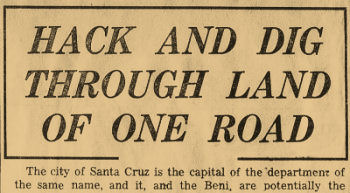University
of Bristol Trans-Continental Expedition 1960 — 61 | ||||||||
| ||||||||
| Published 27 June 1961 | ||||||||
The city of Santa Cruz The city of Santa Cruz is the capital of the department of the same name, and it, and the Beni, are potentially the most interesting parts of the country. It is around 1,400 feet above sea level, compared to the 12,000 feet of the Altiplano, has a tropical climate, grasslands and forests of mixed trees, including giant palms and the spectacular tahiba which is over 30 feet tall and covered with red flowers. There are extensive plans afoot for colonizing the area. This will involve clearing the land; a great task. Also there are problems of re-orientation for the inhabitants of the overpopulated Altiplano who are being brought down here by slow stages. The difference between the Altiplano and the low-lying Santa Cruz and Beni departments is astonishing in so small a country. The latter belong to the headwaters of the Amazon and are separated from the rest of the country by the formidable Cordillera Oriental and the Cordillera Real of the Andes. Down here grow grapefruits, oranges, limes, bananas, sugar, cane, coffee, cotton and even rice. Disease The main drawback is the heat and its accompanying hazards of insects, virtually unknown on the Altiplano, and strange diseases. The Bolivian Government has already established three colonies, comprising 1,311 families. There are also three colonies of Japanese and two of Okinawans. Their difficulties are great, but the prospects good. But as everywhere in Bolivia, the most obvious handicap is the lack of good communications. Our trip out to a government colony, a matter of 15 miles took us 11 ½ hours. That was the worst journey yet, digging, winching, chopping down trees to give grip to the wheels, and all the time being bitten by mosquitos. This was supposed to be the dry season too. The colony is virtually isolated for three months during the rains. From Santa Cruz we drove along the only good road in Bolivia, the highway to Cochabamba, on the way back to La Paz. It is over three hundred miles long and asphalted all the way. It was built by the American Point Four organisation to help open up the department of Santa Cruz. We enjoyed it all the more since Santa Cruz itself does not possess one paved street, just mud and water; the only method of transport is by horse or four wheel-drive vehicle. The taxis are jeeps. Colonial But the cities of the south are old and gracious. Traces of colonial architecture remain and there are many colonnaded squares enclosing gardens and cultivated trees. The climate is delightful, warm and sunny, without being humid. They say that Cochabamba has permanent springtime. They also say it has the prettiest girls in Bolivia. We could not stay long, and returned up the Andes to La Paz. If Bolivia has enormous problems, it also has many potential solutions. There is the necessity for organisation, money, and above all, time; everything seems to be a first priority. The overpopulated highlands are subject to severe frosts and harvests are often cruelly affected, but plenty of room exists in the south and east for people once they can be moved, and the land opened up. A zinc mine near La Paz awaits exploitation, an iron deposit close to the Brazilian border could prove to be one of the richest in the world, possibly up to two hundred million tons of 90-100 per cent iron. There are other sources as well, of iron, lead, lignite, diamonds, gold and silver, not to mention oil and Brazil nuts. The great need is to promote confidence in foreign investors. Some observations on these social and industrial problems will follow in the next article. Editorial note: - When we were there in 1961 the city of Santa Cruz had a population of approximately 50,000 now it is over 2,000,000 and Bolivia's most populated city. The land for hundreds of kilometers to the north and west has been cleared and is used for agriculture [2014] The iron on the Brasilian border is being exploited
| ||||||||
|


 Part
Two of MALCOLM McKERNAN'S Report from Bolivia
Part
Two of MALCOLM McKERNAN'S Report from Bolivia